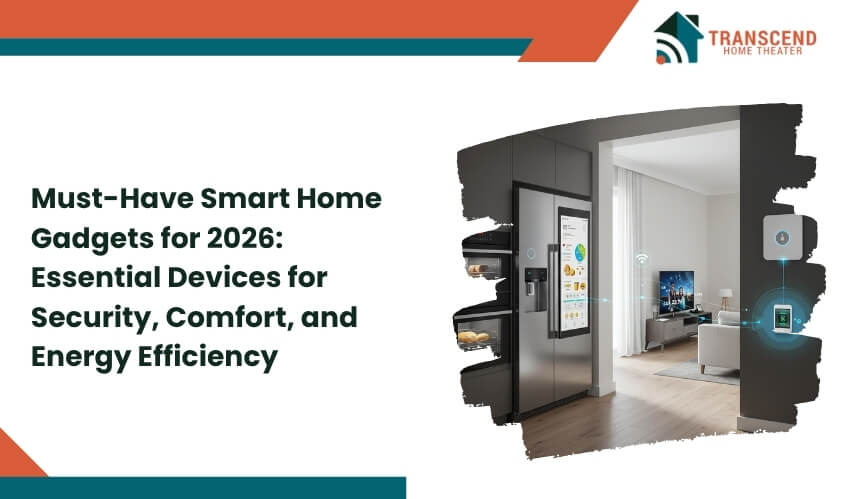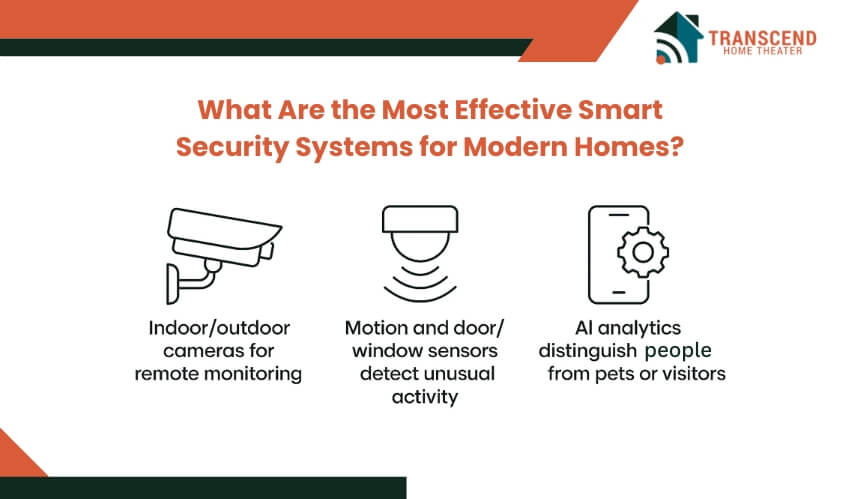Must-Have Smart Home Gadgets for 2026: Essential Devices for Security, Comfort, and Energy Efficiency

By 2025, over 63% of U.S. households had at least one smart home device, and nearly 20% boasted six or more. This surge reflects a global shift towards homes that are not just connected but intelligently responsive. In 2026, the smart home landscape has evolved, offering innovations that enhance security, comfort, and energy efficiency.
From AI-powered security systems and energy-saving appliances to smart plugs, automated shades, and voice-controlled assistants, today’s smart home gadgets are more intuitive and integrated than ever. These devices work together to create a connected ecosystem that enhances security, comfort, and energy efficiency in everyday life.
In this article, we’ll explore the top smart home gadgets of 2026, focusing on those that offer tangible benefits in safety, comfort, and energy savings.
Essential Smart Home Security Devices for 2026

In 2026, security devices go beyond surveillance. They anticipate threats, notify you in real-time, and integrate seamlessly with other smart home gadgets.
What Are the Most Effective Smart Security Systems for Modern Homes?

Smart security systems now use AI-driven analytics to detect unusual activity, distinguishing between pets, visitors, and potential intruders. Key devices include indoor and outdoor security cameras, motion sensors, and door/window sensors.
These systems provide remote monitoring through smartphones, ensuring that homeowners can respond immediately to alerts. Multiple systems can communicate with each other to create a layered security network, increasing reliability and minimizing false alarms.
For homeowners looking to implement a complete system, working with a trusted smart home automation company ensures that devices are configured correctly, connected efficiently, and optimized for both security and convenience.
How Do Smart Locks and Sensors Strengthen Home Safety?
Smart locks and entry sensors replace traditional keys with secure digital access, enabling homeowners to control who enters the house and when. They can automatically lock doors, send notifications if a door or window is opened unexpectedly, and even integrate with alarm systems.
When combined with motion detectors and smart cameras, these devices form a comprehensive defense system that works around the clock without manual intervention.
How Do AI-Powered Security Devices Minimize False Alerts?
Advanced smart security systems leverage machine learning to reduce false alerts caused by pets, shadows, or weather. AI algorithms analyze movement patterns and environmental changes, notifying homeowners only when genuine anomalies occur. This ensures that alerts are actionable, helping users focus on real security threats without constant interruptions.
Must-Have Smart Home Devices for Comfort and Convenience

Smart home technology goes beyond security, transforming everyday living into a seamless and personalized experience. In 2026, comfort-focused devices not only automate tasks but also adapt to your routines, making your home more intuitive, convenient, and enjoyable.
How Can Smart Thermostats Optimize Comfort and Energy Use?
Smart thermostats monitor your daily patterns and adjust heating or cooling automatically, maintaining ideal temperatures while reducing energy waste. They learn from your behavior to anticipate needs and can be controlled remotely, giving you consistent comfort whether you’re home or away.
Some models also integrate with other devices, like smart blinds or ventilation systems, to optimize overall home climate efficiently.
What Are the Benefits of Intelligent Lighting Systems in Smart Homes?
Smart lighting systems allow you to set schedules, control brightness, and change color tones to suit different moods and activities. Automated lighting can respond to motion, time of day, or occupancy, enhancing convenience and reducing electricity usage. By syncing with other smart devices, lighting can also contribute to home security and energy efficiency, creating a well-rounded smart ecosystem.
How Do Smart Plugs Improve Daily Life?
Smart plugs enable you to control household appliances from anywhere, using a smartphone or a voice assistant. Whether it’s turning off lights, adjusting heating devices, or managing kitchen appliances, smart plugs offer hands-free control and enhanced accessibility.
They are ideal for devices that aren’t inherently “smart”, like lamps, coffee makers, or fans, transforming them into connected gadgets.
Take control of your home with seamless automation. Easily manage lighting, temperature, and security from one app, with premium automation brands. Enjoy full integration with popular voice assistants and a 2-year installation warranty with Transcend home theaters.
Energy-Saving Gadgets for a Sustainable Home in 2026

In 2026, energy-saving gadgets will be a key component of creating a more sustainable and efficient home. These devices go beyond simply reducing energy consumption. They actively monitor usage, optimize performance, and integrate seamlessly into your home’s ecosystem.
Key Energy-Saving Gadgets for 2026
- Energy Monitors: Energy monitors provide real-time tracking of your home’s electricity use, showing exactly where and when energy is being consumed. They help identify inefficiencies, enabling users to make smarter decisions on appliance usage and cut back on unnecessary energy consumption.
- Smart Plugs with Energy Monitoring: Smart plugs allow you to control appliances remotely, while also tracking their energy use. Turning off appliances when not in use prevents standby power consumption, a major source of wasted energy.
- Smart Water Heaters: These devices monitor water usage patterns and adjust the temperature accordingly, preventing energy waste from overheating water. Some models even allow for scheduling, ensuring hot water is available when needed without unnecessary energy usage.
- Solar Panels with Energy Management Systems: Solar panels convert sunlight into renewable energy, while an integrated energy management system ensures your home uses solar power efficiently. These systems can store excess energy and automatically switch between solar and grid power to maximize energy savings.
Smart Home Integration and Control: Streamlining Your Devices

In 2026, the real power of smart home technology lies in integration. It’s no longer enough to have standalone devices; the key is ensuring that your gadgets can work together seamlessly.
From central hubs to voice-controlled assistants, integration makes it possible to create a more connected, automated, and intuitive living space.
How Do Smart Home Hubs Centralize Control of Your Devices?
Smart home hubs serve as the backbone of home automation, connecting and managing multiple devices from a single platform. These hubs enable homeowners to create routines, group devices, and control them with ease.
By centralizing control, hubs make it simple to integrate everything from security cameras to lighting systems, ensuring smooth communication between devices.
Many hubs also support voice control, allowing for hands-free operation while maintaining compatibility with a wide range of devices across different brands.
How Do Voice Assistants Simplify Smart Home Control?
Voice assistants like Amazon Alexa, Google Assistant, and Apple Siri enhance the smart home experience by enabling hands-free control. With simple voice commands, users can adjust lighting, control thermostats, lock doors, or play music.
By integrating these assistants into your smart home setup, you gain the convenience of controlling multiple devices at once, further streamlining the user experience and increasing overall efficiency.
Frequently Asked Questions
How Will Smart Homes Evolve in Terms of Privacy and Security in 2026?
As smart homes become more connected, ensuring privacy and data security will be a top priority. In 2026, expect advanced encryption methods, biometric authentication, and AI-driven security protocols to enhance protection.
These technologies will not only safeguard personal data but also provide more granular control over what information is shared and with whom. Smart home systems will likely include built-in privacy features to prevent unauthorized access and improve user control over personal data.
Can Smart Homes Help with Health Monitoring and Wellness in the Future?
Yes, health monitoring will become a crucial part of the smart home experience in the coming years. In 2026, smart homes will likely integrate health-focused devices such as air quality monitors, sleep trackers, and fitness devices that work together to provide a holistic view of your wellness.
These devices can monitor environmental factors like air quality and adjust lighting and temperature to improve sleep quality, all while integrating with wearable health tech for a more comprehensive approach to personal well-being.
What Impact Will 5G Have on Smart Home Automation and Device Performance?
5G will revolutionize smart home automation by providing faster, more reliable connectivity with minimal latency. This will enhance the performance of devices that require real-time communication, such as security cameras, sensors, and home assistants.
As 5G enables more simultaneous connections without interference, it will allow for seamless operation of numerous devices in a smart home, facilitating faster automation and more responsive systems.
What Are the Latest Innovations in Smart Home Entertainment Systems?
In 2026, smart home entertainment will evolve with the integration of immersive technologies like augmented reality (AR) and virtual reality (VR). Expect smart TVs to incorporate 3D or AR features for more interactive viewing experiences.
Additionally, sound systems and entertainment hubs will become more intelligent, automatically adjusting to the room’s acoustics and content type for an enhanced audio-visual experience.
Streaming and gaming platforms will also see more integration with smart home networks, providing seamless control through voice or gestures.
Can Smart Homes Contribute to Sustainability and Green Living?
Yes, smart homes are expected to play a significant role in promoting green living. Devices will be more energy-efficient and designed to reduce environmental impact.
Solar-powered gadgets, smart irrigation systems, and water-efficient devices will become commonplace, allowing homeowners to reduce their carbon footprint.
Smart energy management systems will also ensure that energy consumption is optimized, providing real-time insights into usage and encouraging eco-friendly habits.
Will Smart Homes Become More Accessible to People with Disabilities?
As smart home technology continues to improve, it will become increasingly accessible to people with disabilities. By 2026, we expect more assistive devices that use AI and voice commands, such as smart lights that respond to voice commands or motion, automated doors, and smart medical devices.
These innovations will help create environments that are easier to navigate and more responsive to the needs of individuals with mobility, visual, or hearing impairments.
